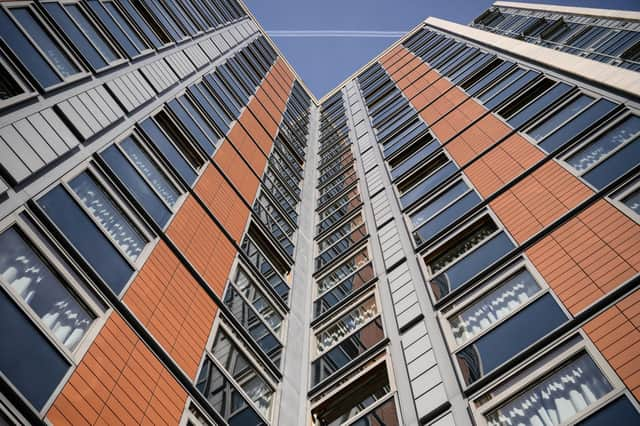Cladding meaning: what is it, why has government announced funding to remove unsafe cladding - and what was Grenfell fire?


Billions of pounds in funding to cover the costs of removing unsafe cladding from high-rise buildings has been announced by the government.
UK Housing Secretary Robert Jenrick said an extra £3.5billion would be provided to remove the cladding from buildings over 18m tall in England “at no cost to residents”.
Advertisement
Hide AdAdvertisement
Hide AdThe country’s cladding crisis, following the Grenfell fire disaster in 2017, has left some homeowners bankrupt and many people facing huge bills for fire-safety improvements.
So, what exactly is cladding, what did the government announce - and what happened during the Grenfell Tower tragedy?
Here is everything you need to know.
What is cladding?
Cladding is the application of materials around the external surface of a building.
It is used to provide thermal insulation, weather resistance, to improve the appearance of buildings and for energy efficiency.
Advertisement
Hide AdAdvertisement
Hide AdMaterials are applied one over another to form a skin or layer.
Cladding was fitted to Grenfell Tower in Kensington, West London, when it was refurbished at a cost of £9million in May 2017.
This was in the form of dense foam boards coated in zinc rainproof sheets which covered the outside of the 23-storey building.
When the fire started, the flames spread easily via the combustible cladding.
Advertisement
Hide AdAdvertisement
Hide AdCladding on similar tower blocks was subsequently ripped down following the disaster - but there is still a cladding crisis in the UK.
What is the cladding crisis?
More than three and a half years since the Grenfell fire, thousands of flat owners across the country are looking at large bills to improve fire-safety in their buildings.
An estimated 700,000 people are still living in high-rise tower blocks which are wrapped in flammable cladding.
After the disaster, which killed 72 people, regulations on cladding changed which meant that people attempting to sell or re-mortgage their homes were unable to do so as they could not provide the correct documentation to prove the cladding on their building met fire safety standards.
Advertisement
Hide AdAdvertisement
Hide AdLeaseholders have also faced other unexpected costs in the wake of the tragedy.
Fire patrols were put in place in hundreds of buildings. These patrols, known as “waking watches”, cost groups of leaseholders tens of thousands of pounds per month.
Leaseholders have had to cover the costs of fixing safety faults, and residents have faced a surge in insurance costs on buildings with fire safety problems.
Data released by the government in January showed that cladding removal and repair work had only been carried out on 58 per cent of social housing blocks and 30 per cent of private sector buildings.
Advertisement
Hide AdAdvertisement
Hide AdThe crisis has been affecting first-time buyers who were not aware that their buildings were wrapped in flammable cladding or had other fire safety faults.
In 2020, the UK Government announced a £1.5billion Building Safety Fund to help with the crisis.
What does the extra government funding cover?
Pressure was growing on the government to increase the funding for residents who are living in flammable buildings before the new sum was announced by ministers on Wednesday 10 February.
Robert Jenrick called the extra money the “largest ever government investment” in building safety.
Advertisement
Hide AdAdvertisement
Hide AdThe £3.5billion comes on top of the £1.5billion announced last year.
Leaseholders in high-rise buildings above 18m, or with six storeys or more, would face no cost for the cladding removal, Mr Jenrick said.
A long-term scheme has also been announced for cladding that needs to be removed in low-rise flat blocks.
As part of the scheme, leaseholders would not pay more than £50 a month for the removal of unsafe cladding, the housing secretary said.
Advertisement
Hide AdAdvertisement
Hide AdA committee of MPs has estimated that the total cost of the cladding crisis could total £15billion.
What happened at Grenfell Tower?
The fire which tore through Grenfell Tower in June 2017 is remembered as one of the UK's worst modern tragedies.
Just before 1am on 14 June, a fire broke out in a Hotpoint fridge freezer in a kitchen on the fourth floor of the 23-storey building.
In a matter of minutes, the flames had reached the exterior of the building and quickly spread to all four sides.
By 3am, most of the tower’s top floors were on fire.
Seventy-two people died in the disaster.
Advertisement
Hide AdAdvertisement
Hide AdExperts have said the composite foam sandwich panels helped the fire to spread from the lower floors to the top of the block.
An investigation by The Guardian claimed that the material used in the tower’s cladding was the cheaper, more flammable version of two available options.
Just two months before the fire started, the London Fire Brigade warned all 33 councils in the city about the risks of cladding on tower blocks.